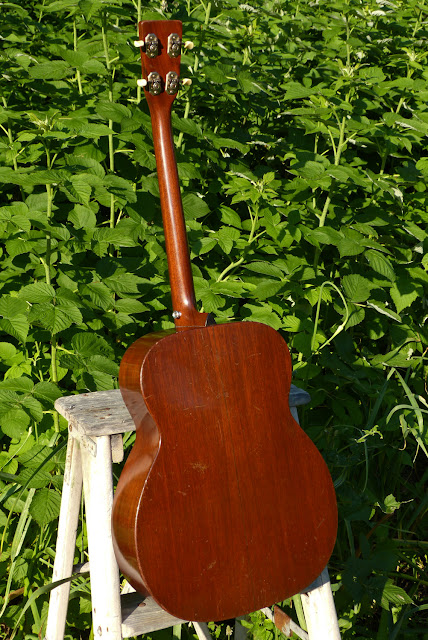1947 Martin 0-17T Flattop Tenor Guitar
1940s mahogany-topped Martins have it going on! That's my conclusion after working-on and playing a bunch of them over the past few years. There's a certain open, woody, airy, lower-mids velvet to them that makes you want to keep playing. It's not a complicated sound -- just a very good, defined, and sweet voice that still manages to carry well. Compared to the littler 5-15T/5-17T models, these 0-17Ts have more warmth and fullness on the bottom end, a sweeter treble, and more actual volume, but their tone isn't as compressed and so they don't have quite the same zip/punch/attack that the size 5 bodies have as the sound is rounder.
Suffice to say, this 0-17T sounds great! I worked on this for a consignment customer and it got a neck reset, fret level/dress, one crack repair, and a good setup. The neck is straight and stable, it has 1 1/16" action at the 12th fret (spot-on), and is good to go. Like the 5-15T I just posted, it also has all of its original equipment and a tall, unshaved, original saddle.
It's a pretty-looking guitar, too, though the finish has use-wear here and there and there's the one repaired crack on the top-lower-bout and one smaller one on the back-upper-bout. While the size 5 tenors are great in higher-pitched tunings, these 0-size tenors sound respectable anywhere from low "Celtic" GDAE tuning to a chimey low-G "uke" GCEA tuning.
I love the ruddy, medium-colored mahogany on this guitar.
While one of the '40s Kluson tuners has a been knob-shaft, they all still work just fine. The nut is 1 1/4" in width, the fretboard is flat, and the neck has a medium soft-V shape to it.
The board, headstock veneer, and bridge are rosewood. The frets have plenty of life left after the level/dress job.
The celluloid pickguard on this guy is a little more brown-red and transparent than later Martins -- and looks the business.
The original saddle is full height, though I did have to add a tiny shim under it to adjust action up.
During setup, I also filled and redrilled the pinholes. Martin had crowded the high string pin-hole a little too close to the next hole, so it necessitated this. It looks tidy, though, and if I didn't tell you I'd done it, you wouldn't even notice.
This is the top, upper bout, bottom edge -- below the bridge -- where a crack was reglued a while back. I took the repair apart and reglued it once again, but there's a bit of finish-wear around the crack. It's a lot harder to see at a glance, however. I've since filled that tiny little 1mm gap at the bottom of the repair. I didn't notice it until I took the pic!
The one non-original bit on the guitar is this strap button. A lame, 70s/80s one was on it and I replaced it with this more vintage-looking Gibson-style aluminum button.
























Comments